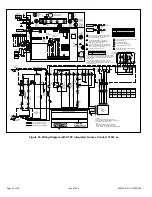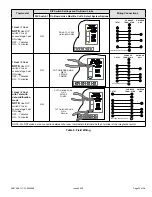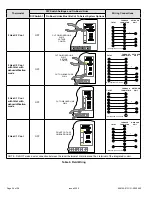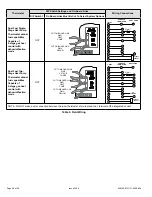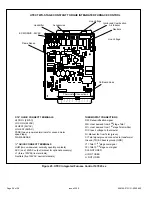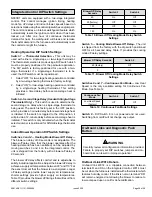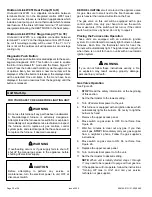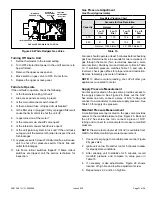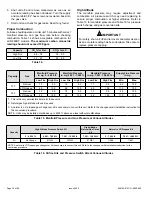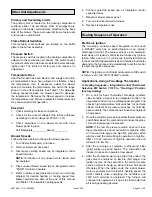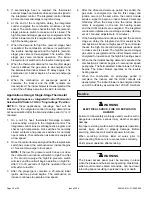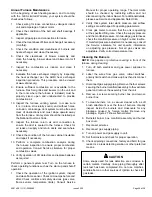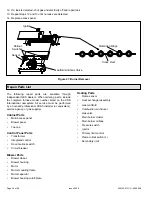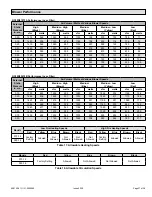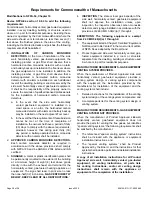
508145-01G / 31-5000660
Issue 2220
Page 35 of 38
Manual for proper operating range. Thermal Limits
should be checked by restricting airflow and not
disconnecting the indoor blower. For additional details,
please see Service and Application Note H049.
2.
Verify that system total static pressure and airflow
settings are within specific operating parameters.
3. Clock gas meter to ensure that the unit is operating
at the specified firing rate. Check the supply pressure
and the manifold pressure. On two-stage gas furnaces
check the manifold pressure on high fire and low fire.
If manifold pressure adjustment is necessary, consult
the Service Literature for unit specific information
on adjusting gas pressure. Not all gas valves are
adjustable. Verify correct temperature rise.
Cleaning the Burners
NOTE:
Use papers or protective covering in front of the
furnace during cleaning.
1.
Turn off both electrical and gas power supplies to
furnace.
2. Label the wires from gas valve, rollout switches,
primary limit switch and make-up box then disconnect
them.
3. Disconnect gas supply piping. Remove the four screws
securing the burner manifold assembly to the vestibule
panel and remove the assembly from the unit.
4.
Remove 4 screws securing burner box and remove
burner box.
5. To clean burners, run a vacuum cleaner with a soft
brush attachment over the face of burners. Visually
inspect inside the burners and crossovers for any
blockage caused by foreign matter. Remove any
blockage. Figure 27 shows burner detail.
6.
Reinstall burner box, manifold assembly and burner
box cover.
7. Reconnect all wires.
8. Reconnect gas supply piping.
9. Turn on power and gas supply to unit.
10. Set thermostat and check for proper operation.
11.
Check all piping connections, factory and field, for gas
leaks. Use a leak detecting solution or other preferred
means.
Some soaps used for leak detection are corrosive to
certain metals. Carefully rinse piping thoroughly after
leak test has been completed. Do not use matches,
candles, flame or other sources of ignition to check for
gas leaks.
CAUTION
Annual Furnace Maintenance
At the beginning of each heating season, and to comply
with the GEA Limited Warranty, your system should be
checked as follows:
1. Check wiring for loose connections, voltage at indoor
unit and amperage of indoor motor.
2. Check the condition of the belt and shaft bearings if
applicable.
3. Inspect all gas pipe and connections for leaks.
4.
Check the cleanliness of filters and change if necessary
(monthly).
5. Check the condition and cleanliness of burners and
heat exchanger and clean if necessary.
6. Check the cleanliness of blower assembly and
clean the housing, blower wheel and blower motor if
necessary.
7. Inspect the combustion air inducer and clean if
necessary.
8.
Evaluate the heat exchanger integrity by inspecting
the heat exchanger per the AHRI heat exchanger
inspection procedure. This procedure can be viewed
at www.ahrinet.org.
9.
Ensure sufficient combustion air is available to the
furnace. Fresh air grilles and louvers (on the unit and
in the room where the furnace is installed) must be
properly sized, open and unobstructed to provide
combustion air.
10. Inspect the furnace venting system to make sure
it is in place, structurally sound, and without holes,
corrosion, or blockage. Vent system must be free and
clear of obstructions and must slope upward away
from the furnace. Vent system should be installed per
the National Fuel Gas Code.
11. Inspect the furnace return air duct connection to
ensure the duct is sealed to the furnace. Check for
air leaks on supply and return ducts and seal where
necessary.
12. Check the condition of the furnace cabinet insulation
and repair if necessary.
13. Perform a complete combustion analysis during
the furnace inspection to ensure proper combustion
and operation. Consult Service Literature for proper
combustion values.
14. Verify operation of CO detectors and replace batteries
as required.
Perform a general system test. Turn on the furnace to
check operating functions such as the start-up and shutoff
operation.
1. Check the operation of the ignition system, inspect
and clean flame sensor. Check microamps before and
after. Check controls and safety devices (gas valve,
flame sensor, temperature limits). Consult Service


